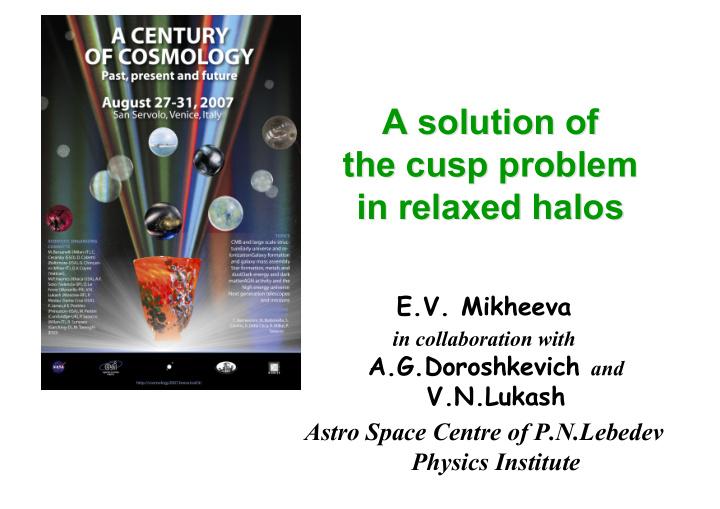



A solution of A solution of the cusp problem the cusp problem in relaxed halos in relaxed halos E.V. Mikheeva in collaboration with A.G.Doroshkevich and V.N.Lukash Astro Space Centre of P.N.Lebedev Physics Institute
Cusp problem: density profiles � (r) � r - � at r � 0 observ servatio tions � < 1 - core � � 1 - cusp N-b -body sim simula latio tions Diemand et al. 2004
The problem of cusp can be solved in the framework of standard � CDM
Idea and method Idea: to take into account the small scale part of initial background perturbations that transforms into random velocities of DM particles in the process of relaxation Method: total entropy = initial (given) + generated (gained during relaxation)
Entropy function Entropy profiles related to density profiles in DM halos for DM particles with isotropic velocity distribution in relaxed halos: p = � <v 2 > = nT = Fn 5/3 entropy function one-dimensional peculiar velocity
� (r) � r - � , Power-law density profiles: �� (0, 2) � 2 3 M M ( r ) ( r ) r dr r � � = = � � � 0 1 dp GM ( r ) + Hydrostatic equilibrium: = � 2 dr r � p = C 1 + C 2 r 2(1- � ) � =1 is a critical value 0< � < 1 - core ( finite pressure in the centre) 1 � � < 2 - cusp ( infinite pressure in the centre)
Entropy mass function F ( M ) C M C M M � � � � + � 1 2 1 2 1 1 2 / 3 � � + � , ( , ) � = ± � � � � 1 , 2 1 2 3 3 � � � � 5 1 � = � � = � = � = cr cr 1 2 6 5 2 5 � � � � � ore : 0 , , , � � � � � � � � 1 2 6 3 6 2 � � � � � = 0 � = 5 4 5 10 � � � � cusp: , , , � � � � � � � � 1 2 6 3 6 3 � � � �
Initial entropy Linear field of density perturbations r r r � Displacement S r x = � r r � Velocity & a 1 V r = = div r � Density perturbation S � = v � Coordinates: Euler ( t , r ) v ( , x ) Lagrange � r ) ( ) 2 2 2 ( 1 2 dt a 1 2 d r + � � � � = ( ) ( ) 2 2 d a 1 2 q 2 B , dx dx � � = � � � � � �� ��
DM halo formation (Zel’dovich approximation) r r r r r r � 1 2 1 r ( z , x ) ( 1 z ) [ x g ( z ) S ( x )] , S 11 h Mpc � = + � � = = r r r r r 1 / 2 V ( z , x ) H ( 1 z ) [ x / 2 g ( z ) S ( x )] � + � 0 r r r r r r r r r S ( x ) S ( x ) S ( x ) , ( x ) ( x ) ( x ) = + � = � + � R * R * local background – protohalo � onditional perturbations with linear scale R [collapsing [transform (adiabatically into virialized halo by z 0 with at least) into microscopic compression factor ~ 5(1+z 0 )] particles’ motion in halo] r r r r r r | x x | R : 1 . 69 ( 1 z ) , S ( x ) S ( x ) � < � � + � 0 R 0 R R 0 r r 2 2 2 S 0 , S ( R ) P ( k )[ 1 W ( kR )] dk = � = � � = � � * * * *
d ln F ( M ) 1 1 � � 2 � � � � = + � � d ln M 3 ln M � � 13 n log ( M / ) M � � n 10 7 4 0 5 0.3 0.5 0.57 0.67 0 . 83 � < � 6 Critical value for �
Generated entropy Violent relaxation entropy (special analytical models) Isotermal shere Collapse of ellipsoide (Fillmore & Goldreich (Gurevich, Zybin 1984) 1988, 1995) 2 4 / 3 ~ r , M ~ r , F ~ M � ~ 1 . 7 1 . 9 � � � g
Analytically modeled halos F ( M ) ~ M , â 5 / 6 � b < b b � F ( M ) ~ M , â 5 / 6 g � g g 2 2 � F ( M ) Ñ M Ñ M � g = b + b g F b ( 0 , 1 ) � = � F
Generated rotation curves F b <<F � b =0.333 � b =0.333 F b ~F NFW � b =0.567 � b =0.567 Burkert � b =0.667 � b =0.667 � g =4/3 (isothermal sphere) r/r max � g =5/6 (NFW)
Conclusions The background entropy can prevent the cusp ! formation for halos with 10 6 M � < M < 10 12 M � ! For smaller and larger galaxies and for clusters of galaxies the impact of background entropy is attenuated ! The impact of the background entropy allows to reproduce the observed rotation curves ! N-body simulations: underestimation of initial perturbations at small scale?
More recommend